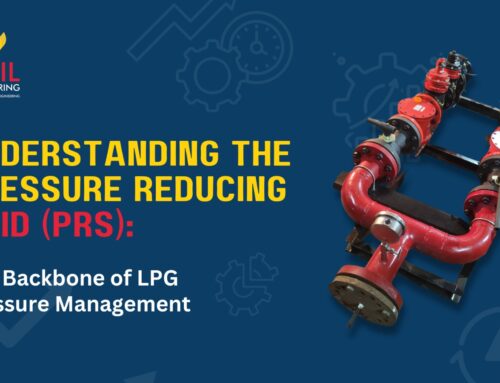In my last article, I spoke about high-pressure and low-pressure liquefiable gases. LPG is a low-pressure liquefiable gas, and other terms like permanent gas, liquefiable gas, critical temperature, critical pressure, and saturation pressure at different temperatures are also commonly used.
Here, I wish to stress the importance of the term saturation pressure at various temperatures.
LPG changes phase very easily, from liquid to vapour or from vapour to liquid, with a slight change in pressure or temperature. This can create problems for industrial burners.
Generally, in Indian ambient conditions, LPG storage tank pressures are in the range of 3 to 7 bar, depending on the ambient temperature at that moment. A pressure regulating station (PRS) is installed in the storage yard. It reduces the vapour pressure to within 1.5 to 2.5 bar for the line connecting the storage tank to the consumption point. A secondary pressure regulator reduces the pressure further to suit furnace burner requirements.
Ambient Conditions and Recondensation
Suppose the ambient temperature is 35°C and the pressure is 2 bar (30psi). During the day, everything will work fine. At night, the temperature falls to, say, 20°C. Remember that LPG in India is a mixture of butane and propane, with a 50:50 proportion. At 35°C, the vapour pressure is 62 psi, much above the actual line pressure of 30psi. So LPG in the line is entirely in the vapour phase. At night, at 20°C, butane in the mixture starts forming liquid because the saturation pressure of butane at that temperature is about 16 psi. The actual pressure is thirty psi, much above the saturation pressure of butane. Some butane vapour becomes liquid in the form of droplets. This process is called “recondensation”. These droplets flow with vapour. They can damage the secondary regulator and also create hazardous situations at the burner. Under such situations, the line pressure must be reduced to 1 bar if possible. But it may not be possible if the line is long, and installing a liquid trap before the secondary regulator will be necessary.
This example explains how the phase change takes place automatically under varying ambient conditions and can create problems for the user.
Charts available in different data books show the saturation pressure of propane, butane, and their mixtures in varying proportions at different temperatures. Vapour pressure in lines should always be maintained to suit the possible low ambient temperature at that location.
One more possible solution is to use 100% propane instead of a P and B mixture. Even at 0°C, it will be in the vapour phase and have a pressure of about 50 psi. But remember, the storage installation must have been designed for propane. You cannot fill propane in a storage tank designed for a P, B mixture. Propane is used in all cold countries, not LPG, a mixture of P and B. In those countries and in Australia, P means propane in the short form of LPG, unlike in India, where P stands for petroleum.
Latent Heat of Vaporization
One more term I wish to introduce here. You are very much familiar with the term boiling point. It is also commonly used for the saturation temperature pressure concept. The boiling point of a liquid at the given pressure is the temperature at which it starts converting into vapour. The temperature remains constant. The heat you add at this stage is called the latent heat of vaporization. The values for P and B are available in data books.
As per physics basics, the boiling point of any liquid increases when the pressure increases.
Water can boil at 100°C under normal ambient pressure, but in boilers, even at a low pressure of 2 bars, the water temperature can reach 120°C. It’s important to understand what liquefiable gases are, their saturation temperature and pressure (vapour pressure), and that propane and butane are examples of such gases. These gases exist in two phases simultaneously in any container at ambient temperature and pressure, with the gaseous phase above the liquid phase, called vapour. Any liquid, when converted to a gaseous phase at ambient temperature, generates vapour and is referred to as a volatile liquid. Permanent gases, however, cannot exist in a liquid phase under ambient conditions and are referred to as gas.
Challenges with Gas Supply
When someone says “Gas supply bandh hai” or “Gas pressure bahut kam hai,” it means there’s a problem with the gas supply, but it shouldn’t matter as long as the understanding is clear. The equilibrium is disturbed when the surrounding temperature changes. An increase in temperature causes the liquid in the container to expand, compressing the vapour above it. Some of the liquid is converted to vapour, requiring more volume and increasing the container pressure. The increased pressure tries to convert some vapour back into a liquid, and finally, equilibrium is reached.
In most applications, the vapour is removed from the container for consumption, which disturbs the equilibrium due to the reduction in pressure. The above-described process starts to restore equilibrium, and the saturation temperature is less for reduced pressure, causing the liquid to start boiling. Heat is required for boiling, and when any liquid is heated, it absorbs and stores that heat, which is automatically used for boiling. Since this heat is used up, its temperature falls below ambient, and heat starts flowing into it from the surrounding through the container walls. Walls cool down, condensing water vapour from the air, resulting in the phenomenon called “Sweating.” The temperature of the liquid in the container drops, and in practice, it can be cooler by 10 to 15°C than ambient.
Another effect of vapour withdrawal is a drop in tank pressure below its vapour pressure at ambient temperature, indicating that more vapour is being removed than can form by natural vapourization. The solution is to reduce consumption or stop using this container (tank) and use another tank if installed. If this is a regular problem, a vaporizer must be installed. Similar to vapour removal, equilibrium is disturbed when liquid is removed from the container, such as in the case of LOT installation or when using a vaporizer. The vapour automatically expands to occupy the additional available volume, causing the pressure in the container to drop, and the flow may reduce, but this is less severe compared to vapour removal.
Depending on its surface area and ambient temperature, every container has a vapour supply capacity. The capacity can be calculated using specific formulas, and ready-made charts are available to give this data. The terms “Volatile liquid” and “Volatility” come into the picture at this stage, and they will be discussed in the next article.



